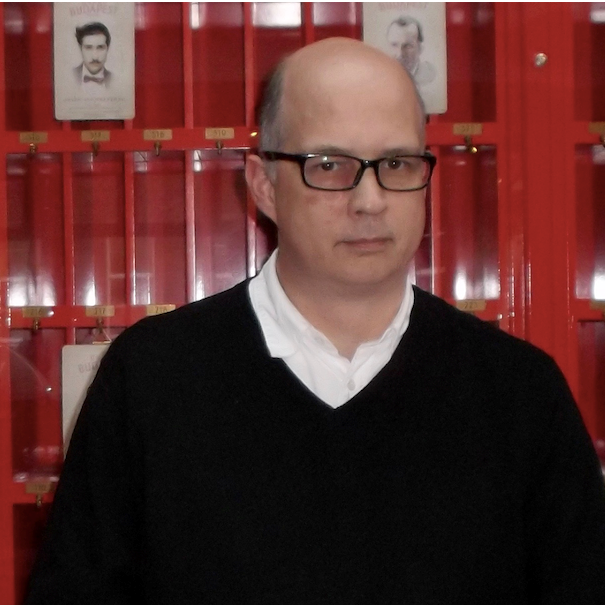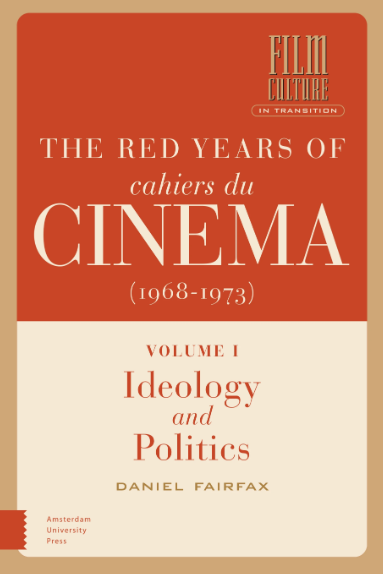
by Daniel Fairfax
Amsterdam: Amsterdam University Press, 2021. 880 pages
$222.18 – €205 (hardback), ISBN 9789463721011
$0 – €0 (ebook), ISBN 9789048543908
Amsterdam University Press website
Open Access volume one volume two
Reviewed by Warren Buckland
Cahiers du Cinéma is a microcosm of the intellectual milieu that spawned it. The journal’s ‘red years’ (1968–1973)—as Daniel Fairfax calls them in his monumental two-volume study—followed broader intellectual trends of the 1960s: the rejection of traditional conceptions of humanism, historicism, economism, and empiricism and the adoption of a rigorous form of theoretical thinking that combined semiology, Lacanian psychoanalysis, Althusser’s structural Marxism and, later, Maoism. Across two volumes, Fairfax focuses on ten key authors during this fervent period in the journal’s history: Jacques Aumont, Pierre Baudry, Pascal Bonitzer, Jean-Louis Comolli, Serge Daney, Bernard Eisenschitz, Pascal Kané, Jean Narboni, Jean-Pierre Oudart, and Sylvie Pierre, several of whom he interviewed for the book.
Fairfax does not set out to create an artificially linear metanarrative from these authors and their positions but instead identifies their formation into multiple networks, most of which were fluid and short-lived due to editorial conflicts, internecine struggles, political transformations, and ideological differences. Fairfax identifies these authors’ core ideas and political affiliations, which he organizes around four principal themes distributed across the two volumes: volume one presents ‘Theories of Ideology’ and ‘Engagements with Politics’ while volume two examines ‘Questions of Aesthetics’ and ‘Encounters with Ontology’. He defines his approach as ‘a rigorous yet creative exegesis of the original Cahiers texts’ (193), with each section focused on key Cahiers essays, supplemented with accounts of the problem situation (the background from with each essay’s theoretical problem arose), the micro-networks of authors, publishers, and filmmakers that surround the creation of those essays, and the journal’s legacy.
That legacy was initially based on four canonical essays that were translated and circulated in Anglophone film studies: Comolli/Narboni’s ‘Cinema/Ideology/Criticism’, the collective text on John Ford’s Young Mr. Lincoln, Oudart’s essay on suture (originally published in two parts), and Comolli’s ‘Technique and Ideology’ (published in six parts). In the 1980s, that legacy was expanded with the publication of a four-volume edited collection that translated essays from the journal’s inception in 1951 up to 1978 (Hillier 1985, 1986; Browne 1990; Wilson 2000). Fairfax’s ambitious study contributes to and considerably expands the discourse on Cahiers du Cinéma in English.
In the late 1960s, with les événements of May 1968 the final catalyst, the Cahiers’ editorial board sought a revolutionary synthesis of culture and politics by rejecting its own brand of journalistic discourse and idealistic theory it had developed since the 1950s (mise-en-scène criticism and la politique des auteurs) in favour of a new form of revolutionary thinking about mainstream cinema that set out to subject it to political criticism, one that would identify its ideological components and disclose its place within the dominant social order. Cahiers initially adhered to Althusser’s political philosophy, which aligned it with the French Communist Party, while its brief liaison with Maoism put the journal to the left of the Althusserians. Theoretical thinking identified new objects of study—a materialist critique of cinema’s reality effect and subject effect, both of which were defined via a complex symptomatic analysis of the ideological effects of underlying hidden structures.
In the ‘Theories of Ideologies’ section, Fairfax establishes the theoretical core of the red years of Cahiers du Cinéma, with ‘Cinema/Ideology/Criticism’ setting its agenda, the Young Mr. Lincoln analysis carrying out a collective ideological reading of the film’s symptoms (the intangible political/historical/sexual meanings the film attempts to repress), and ‘Technique and Ideology’ examining the ideological and economic demands placed on cinema in a capitalist society. But, for Fairfax, Jean Narboni’s ‘La Vicariance du Pouvoir’ (on Straub/Huillet’s Othon [1969]) is equally significant, for it ‘provides a template for the modernist poetics defended by Cahiers in terms of subject matter, theoretical reference points and even the critic’s own writing style’ (41).
In the ‘Engagements with Politics’ section, Fairfax traces the journal’s attempts to redefine political criticism and political cinema, a long process that began by deposing Éric Rohmer as editor in 1963 and shifting to the left with Jacques Rivette’s editorship followed by Comolli in 1965, plus a period of instability signalled by the journal’s split with media tycoon Filipacchi in 1969 to become an independent publication. This move saw Cahiers align itself with the politics of the Tel Quel group (especially Philippe Sollers) and the French Communist Party (including its cultural journal La Nouvelle Critique). This alignment fell apart in 1971 when Cahiers split from the French Communist Party and aligned itself with Maoism—again under Sollers’s influence, but also following Godard’s lead, the journal’s former film critic who became its quintessential representative of political cinema. (Fairfax devotes chapter 10 to a detailed investigation of Godard’s influence on Cahiers du Cinéma from 1969 to 1973.) During its Maoist period, Cahiers promoted political activism and denounced its own previous efforts at developing film theory and criticism (its focus on film form and symptomatic analysis, aided by the theories of Althusser, Barthes, and Lacan) in favour of its promotion of class struggle. The film criticism it did publish during this time (except for Comolli’s series on ‘Technique and Ideology’—which Fairfax has translated in full in a separate volume [Comolli 2015]) was focused primarily on the content of films (290). Fairfax reproduces Sylvie Pierre’s exasperation at the journal’s direction, expressed in a letter written in March 1972:
‘I read with consternation and I formally disapprove in principle of the text “Intervention 1” published last January. It is not for us to give lessons in Marxist-Leninist theory to the universe. […] We should not abstain from taking sides, but rather, choose an option that above all orients our own practice, that is, the critique and analysis of film’ (Pierre, quoted on p. 280; emphasis in the original).
Pierre’s words were prescient, for sectarian disputes and the reality of Mao’s cultural revolution led to the collapse of Maoism in Cahiers in 1973, reflecting the demise of Maoism in France more generally. Fairfax charts the efforts of Serge Daney and Serge Toubiana to steer the journal away from its dogmatic allegiance to Marxism back to its status as a preeminent critical and theoretical film journal. He concludes that ‘the critical texts of [Cahiers’] dogmatic Maoist moment fundamentally represent an aberration in the history of the journal’ (290; emphasis in the original).
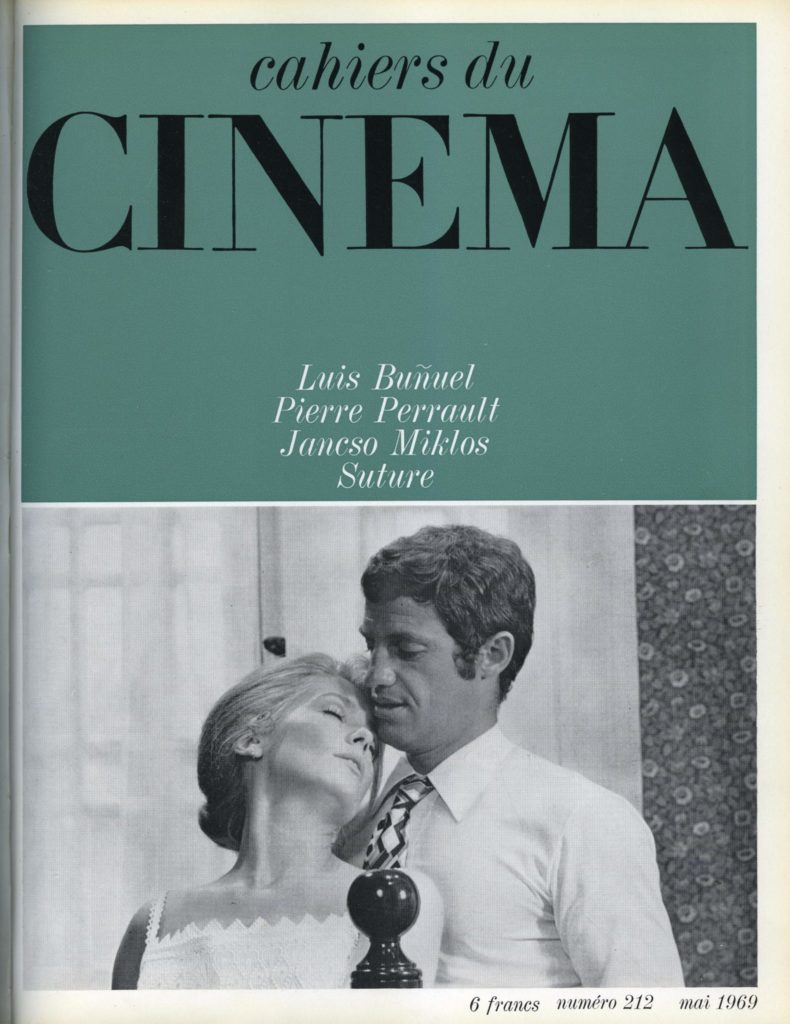
Volume two demonstrates the diversity of Cahiers du Cinéma’s interests during its Marxist phase. The ‘Questions of Aesthetics’ section shows that mise-en-scène criticism and auteurism did not completely disappear from the journal during its red years; instead, the former was transformed into cinematic écriture and auteurs continued to be privileged as long as they challenged mainstream filmmaking—either from within (the editors continued their symptomatic readings initiated in the collective text on Young Mr. Lincoln with an analysis of Sternberg’s Morocco and Cukor’s Sylvia Scarlett)—or if they promoted a political modernist agenda (not only European auteurs but also an acknowledgement of World cinema). Semiology, structuralism, and formalism are included in this section, together with career profiles of Jacques Aumont, Pascal Kané, and Serge Daney.
The final section, ‘Encounters with Ontology’, devotes individual chapters to the work of Pierre Baudry, Bonitzer, and Deleuze. But dominating this final section are two authors whose presence is in fact felt throughout the two volumes: André Bazin and Jean-Pierre Oudart. Fairfax argues that Bazin’s ontological realism continued to play an influential role in Cahiers du Cinéma post-1968 even though his theory was labelled idealist, an argument worth exploring in detail elsewhere. Here I plan to close this review with an extended account of Oudart’s presence throughout the two volumes. Fairfax begins by noting that ‘Oudart’s status is a mystery: the prevailing hypothesis among his former colleagues is that he was interned in a mental institution in the 1980s, and his present situation—or even whether he is alive or dead—is unknown’ (21). Furthermore, very little is known about his background:
‘No record exists of his date of birth or family background, although de Baecque relays that he worked at the municipal library in Orléans and had read Cahiers attentively since the early 1960s. From 1967 onwards, he dispatched hand-written letters to the journal, and after an in-person meeting with the editors, began to publish with Cahiers in January 1969’ (245).
Fairfax notes that Oudart’s knowledge of cinema was minimal in relation to the rest of the editorial team, but he made up for this with his knowledge of Lacanian psychoanalysis. Soon after joining the editorial board, Oudart published the first instalment of his two-part theoretically complex essay on suture, which became one of the most influential theoretical essays published in Cahiers. But Oudart’s presence in the journal extended beyond the concept of suture: he also wrote theoretical essays on new releases very quickly; he contributed to the symptomatic reading of Young Mr. Lincoln, writing the dense theoretical ending called ‘violence and the law’ (on the position of the mother in Young Mr. Lincoln); he primarily wrote the ‘sequel’ to that essay, an analysis of Morocco; and he co-authored several other influential essays (including ‘Travail, lecture, jouissance’ and ‘Le Nom-de-l’Auteur: à propos de la “place” de Mort à Venise’, both with Serge Daney). We also learn that the obscurity of Oudart’s writing hastened the journal’s break with Filipacchi, affected subscriptions, and even challenged the journal’s other editors. Pierre said in her interview with Fairfax: ‘We always had a lot of trouble, when he wrote on a film, in understanding the literal relationship of the analysis that he had woven with the film’ (486). And in Chapter 22 (‘Jean-Pierre Oudart and Suture’), Fairfax argues that Oudart was both central and peripheral to Cahiers du Cinéma:
Central, because his attempts to import psychoanalytic concepts into film theory were a core component of the Cahiers project and gave rise to the concept of suture, one of the journal’s key legacies for film theory. Peripheral, due to the thoroughly idiosyncratic nature of his textual output, which invariably left his colleagues torn between admiration and bewilderment. (665)
Oudart authored or co-authored over 80 articles for the journal between 1969 and 1980 (not only the two-part essay on suture but also theoretical interrogations of representation more broadly and the relationship between cinema and post-Renaissance European painting), but he never published elsewhere.
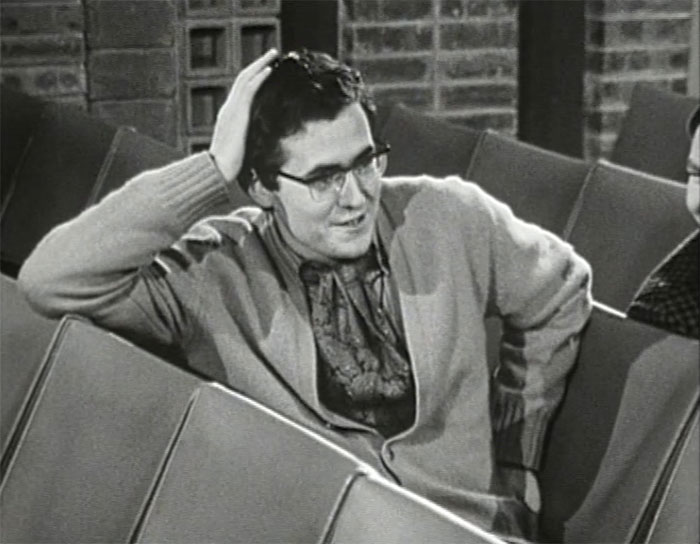
Earlier, Fairfax asks whether the texts written during the red years were simply obscure or whether they articulated complex ideas. He observes that ‘Oudart’s contributions were particularly notorious for their hermetic inscrutability, but all the writers at Cahiers flirted with forms of writing that markedly departed from the norms of compositional limpidity’ (486). To some extent, the obscurity is due to the way Oudart’s conception of cinematic suture was employed by others; its wider adoption ‘led to a certain betrayal of Oudart’s thinking’, a betrayal in the form of ‘a taming of the moments of theoretical wildness in Oudart’s original article’ (675).
To address this ‘betrayal’, I shall momentarily turn away from Fairfax’s general exegesis in order to explore the possibility of a philological reading of theoretical texts. In chapter 3 of Humanism and Democratic Criticism called ‘The Return to Philology’ (2004), Edward Said defined a ‘true philological’ reading as one that ‘involves getting inside the process of language already going on in words and making it disclose what may be hidden or incomplete or masked or distorted in any text we may have before us’ (2004, 59). Said criticizes readers who move too quickly from a superficial reading of a text to general statements about social systems, power structures, or an author’s worldview: ‘Only by receiving the text in all its complexity’, he argued, ‘can one move from the specific to the general’ (2004, 61). A philological reading conceived as a systematic technical analysis of a text’s language avoids a superficial reading that betrays a text and its author. Philology, in other words, can return us to Oudart’s essay on suture in all its complexity and disclose what is hidden, incomplete, masked, or distorted through its language. A philological reading discovers that Oudart’s text is elliptical: it omits many premises, lacks descriptive detail, and fails to expand its tersely expressed ideas. It comprises a large number of passive sentences, and it employs the rhetorical figure of polysyndeton. The latter technique binds together several phrases using conjunctions such as and, which tend to create long sentences that give equal weight to all the concepts expressed in the sentence. The effect is to slow down the reader in order to contemplate the sentence’s long series of interconnected ideas. For example:
In La Chinoise Godard poetically exasperates this fissure between what might be called the ‘thing’ of the image and its fragile and precious signs, between its reified discourse and the background of opaqueness against which it stands out and to which colour gives a quasi-pictorial density. (Oudart 1977/78, 36–37)
[Dans une œuvre comme «La Chinoise», Godard a très poétiquement exaspéré cette déchirure entre ce qu’on pourrait appeler la chose de l’image et ses signes, fragiles et précieux; entre son discours, réifié, et le fond d’opacité sur lequel il se détache, auquel la couleur donne une densité quasi picturale. (Oudart 1969, 37)]
This, for Oudart, is an average-length sentence of 46 words in English (49 in French), held together by four repeated conjunctions (and) (in the French text there are only three uses of et) and the repetition of two prepositions (between/entre) that create a parallel between the ‘thing’ of the image and signs on the one hand and reified discourse and the opaque background on the other hand. And while the reader is contemplating the relations between these four abstract ideas, a final conjunctive and is added—at least in the English translation (in the French original Oudart simply uses a comma between se détache and auquel), followed by the phrase ‘to which colour gives a quasi-pictorial density’. Oudart does, however, use a semi-colon before listing the third and fourth concepts, which has two effects: it encourages the reader to draw parallels between what comes before and after the semi-colon, and it marginally lessens the feeling of a long series of interconnected ideas. Linking these concepts without conjunctions (asyndeton, the opposite of polysyndeton) would have the reverse effect, of hurrying the reader over these abstract concepts. In this lengthy and complex sentence Oudart therefore assists the reader with conjunctions and a semi-colon but hinders comprehension with hidden premises, terse expressions, and abstruse vocabulary. This is just the beginning of a philological analysis, the first tentative step in determining how Oudart’s seminal and influential essay is composed and how it both expresses complex ideas and creates obscurity.
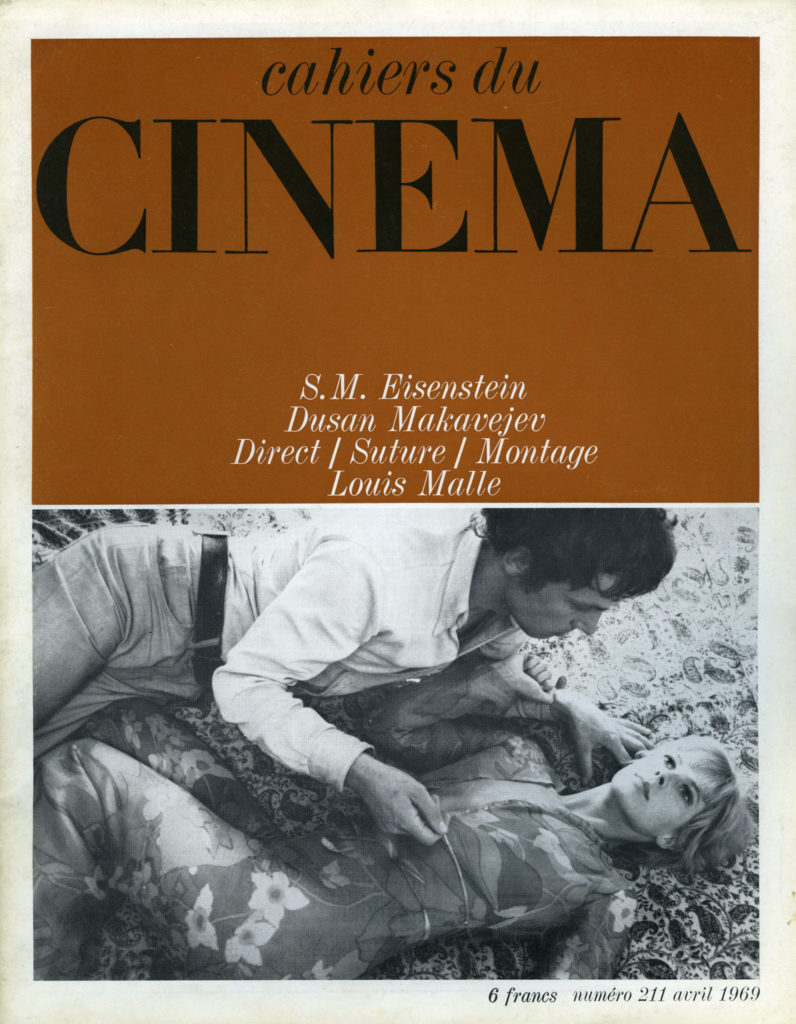
Throughout The Red Years of Cahiers du Cinéma, Fairfax presents a faithful, even-handed exegesis, a ‘history of ideas’ that takes a curious glance back into a radical moment of ‘pure theoreticism’. Yet, despite the book’s length, he still has to resort on occasions to pithy summaries of complex theories (semiology, structuralism, deconstruction, Kristeva’s semanalysis, Lacanian psychoanalysis, etc.). And the nonlinear multiple narrative form does at times create a disjointed text—the Young Mr. Lincoln symptomatic analysis is discussed in chapter 3 (volume 1), whereas the follow-on analyses are not discussed until chapter 16 (in volume 2). But this one of the inevitable consequences of adopting non-linear narration.
Finally, these two volumes remind us that 1960s theory (specifically, its anti-humanist theory of subjectivity) offers a corrective to the current dangers of an inward-looking narrow identity politics focused on individual responsibility and immediate lived experience. This narrow politics, premised on the false belief in the autonomy of the Cartesian subject, reduces political critique and theoretical analysis to the interpretation of the world as it appears to individual consciousness. Although experienced as pre-given and authentic, consciousness and subjectivity are—as the anti-humanists remind us—effects of the symbolic order (or the ‘Borromean knot’ of the Imaginary, the Symbolic, and the Real), just as the cinematic experiences presented to consciousness—including the impression of reality generated by mainstream films—are similarly an ideological effect of the cinematic apparatus.
Works Cited
Browne, Nick, ed. 1990. Cahiers du Cinéma, 1969–1972: The Politics of Representation. London: Routledge.
Comolli, Jean-Louis. 2015. Cinema Against Spectacle: Technique and Ideology Revisited. Edited and translated by Daniel Fairfax. Amsterdam: Amsterdam University Press.
Hillier, Jim, ed. 1985. Cahiers du Cinéma, the 1950s: Neo-Realism, Hollywood, New Wave. Cambridge, Mass.: Harvard University Press.
Hillier, Jim, ed. 1986. Cahiers du Cinéma, 1960–1968: New Wave, New Cinema, Reevaluating Hollywood. Cambridge, Mass.: Harvard University Press.
Oudart, Jean-Pierre. 1969. ‘La suture’. Cahiers du Cinéma, 211: 36–39.
Oudart, Jean-Pierre. 1977/78. ‘Cinema and Suture’. Screen 18 (4): 35–47.
Said, Edward. 2004. Humanism and Democratic Criticism. New York: Columbia University Press.
Wilson, David, ed. 2000. Cahiers du Cinéma, 1973–1978: History, Ideology, Cultural Struggle. London: Routledge.

